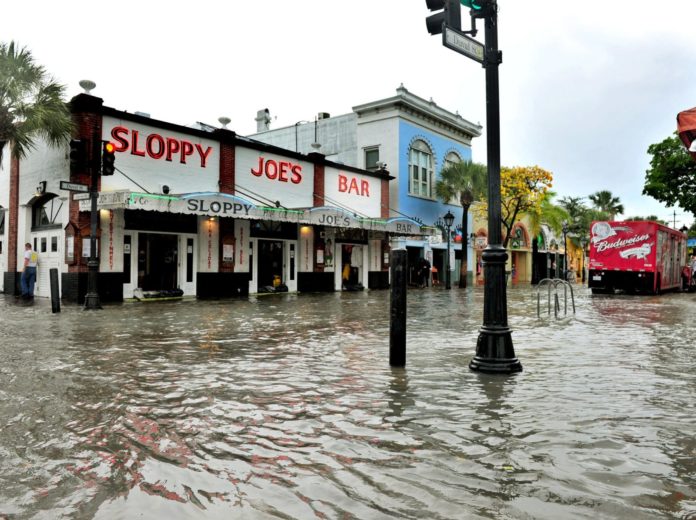In the Upper Keys, a 73-year-old resident has decided to no longer purchase flood insurance, even though the ground floor of her primary home of decades was flooded with three feet of water after Hurricane Irma. Why? “I can’t afford the premiums any more,” she said.

But in written statements to Keys Weekly, U.S. Sen. Marco Rubio and U.S. Rep. Carlos Giménez said they are fighting for lower flood insurance premiums in Congress for their many constituents who live in coastal areas, including in the Florida Keys. In November, Rubio co-led, and Giménez signed on as a co-sponsor for, the National Flood Insurance Program Reauthorization Act, which would cap annual premium increases at 9 percent.
“The bill fixes major problems with the current NFIP program and would make needed reforms to the misguided Risk Rating 2.0. By capping annual rate increases … this NFIP reform legislation would be a huge win for the residents of Monroe County,” said Giménez.
Risk Rating 2.0 is FEMA’s new method of calculating premiums for its National Flood Insurance Program (NFIP). The calculations are based on the value of policyholders’ homes and the flood risk of individual properties. According to FEMA, 96% of current policyholders will see either an immediate decrease or $20 less per month in their premiums under the new pricing system.
However, Fair Insurance Rates in Monroe (FIRM), a nonprofit watchdog group, said their database analysis shows something vastly different when looking at the Keys.
“Monroe County flood policy owners could expect increases averaging $3,200 annually,” FIRM said in a statement.
“FIRM’s rate analysis is thousands of dollars higher than FEMA’s projected increases and contradicts them sharply. FEMA has said rates should increase about $240 annually for almost 93% of Monroe County policyholders.”
The first phase of Risk Rating 2.0 rolled out on Oct. 1, 2021, for new flood insurance policy owners, and the second phase will hit all policy owners on April 1, 2022.
Mel Montagne is the president of FIRM as well as the vice president of sales for Insurance Office of America. He told Keys Weekly that FIRM has been deciphering the effect of Risk Rating 2.0 on new policy holders since October, but “we have had instances here in the office where we’ve quoted new flood insurance policies to buyers and they’ve gone on to other properties. … At a minimum, current policyholders can expect an 18 percent to 25 percent increase in their premiums in April.”
Per federal statutes, NFIP annual increases are capped at 18% for primary residential properties and 25% for second homes and commercial properties. Therefore, if the NFIP Reauthorization Act of 2021 succeeds in capping annual premium increases at 9 percent, Monroe County homeowners’ bank accounts won’t be as stretched thin.
However, according to Lisa Tennyson, the county’s director of legislative affairs, the future of the NFIP Reauthorization Act of 2021 is unclear.
“The Senate and the House are busy with other things,” she said. “It’s a matter of what gets their attention, and right now NFIP doesn’t compete with that. However, after April 1, when the bulk of policy owners feel impacts of Risk Rating 2.0, the public’s response to those impacts could spur movement.”
But Tennyson pointed out that fighting for lower flood insurance premiums can have an image problem on the Hill.
“Opponents argue that the main beneficiaries of affordable flood insurance are wealthy people with upscale homes in coastal communities,” she said. “And of course, we know that not to be true. Teachers, nurses, firefighters, government workers — these are the main beneficiaries of affordable flood insurance.”
Keys Weekly asked both Giménez and Rubio what they would tell that 73-year-old homeowner who has decided to forego flood insurance.
Giménez said, “If she called my office, I would have one of our professional caseworkers walk through the government programs available to her to help ease the burden. This is another great example that proves NFIP reform isn’t just for the second homes, it’s for the people who have to deal with these flooding issues day in and day out. This impacts real people, not just a wealthy few.”

Rubio said, “I understand the challenge, and it is why we need fairly and transparently priced insurance rates. Unfortunately, President Biden’s Risk Rating 2.0 will only make things worse, which is why I continue to fight for long overdue reforms to the program.”
Tennyson urges Monroe County homeowners to be proactive.“I encourage everyone to pay attention to Risk Rating 2.0 and contact federal elected officials. Let Giménez, Rubio and (U.S. Senator Rick) Scott know how important this issue is to you,” she said.
























